
paddler
Stateful load balancer custom-tailored for llama.cpp 🏓🦙
Stars: 715

Paddler is an open-source load balancer and reverse proxy designed specifically for optimizing servers running llama.cpp. It overcomes typical load balancing challenges by maintaining a stateful load balancer that is aware of each server's available slots, ensuring efficient request distribution. Paddler also supports dynamic addition or removal of servers, enabling integration with autoscaling tools.
README:
[!IMPORTANT]
Big chances! Paddler is rewritten into Rust (from Golang) and uses Pingora framework for the networking stack.Version
1.0.0brings some minor API changes and reporting improvements.The next plan is to introduce a supervisor who does not just monitor llamas.cpp instances, but to also manage them (replace models without dropping requests, etc.).
Paddler is an open-source, production-ready, stateful load balancer and reverse proxy designed to optimize servers running llama.cpp.
Typical load balancing strategies like round robin and least connections are ineffective for llama.cpp servers, which utilize continuous batching algorithms and allow to configure slots to handle multiple requests concurrently.
Paddler is designed to support llama.cpp-specific features like slots. It works by maintaining a stateful load balancer aware of each server's available slots, ensuring efficient request distribution.
[!NOTE] In simple terms, the
slotsin llama.cpp refer to predefined memory slices within the server that handle individual requests. When a request comes in, it is assigned to an available slot for processing. They are predictable and highly configurable.You can learn more about them in llama.cpp server documentation.
- Uses agents to monitor the slots of individual llama.cpp instances.
- Supports the dynamic addition or removal of llama.cpp servers, enabling integration with autoscaling tools.
- Buffers requests, allowing to scale from zero hosts.
- Integrates with StatsD protocol but also comes with a built-in dashboard.
- AWS integration.
Paddler's aware of each server's available slots, ensuring efficient request ("R") distribution
llama.cpp instances need to be registered in Paddler. Paddler’s agents should be installed alongside llama.cpp instances so that they can report their slots status to the load balancer.
The sequence repeats for each agent:
sequenceDiagram
participant loadbalancer as Paddler Load Balancer
participant agent as Paddler Agent
participant llamacpp as llama.cpp
agent->>llamacpp: Hey, are you alive?
llamacpp-->>agent: Yes, this is my slots status
agent-->>loadbalancer: llama.cpp is still working
loadbalancer->>llamacpp: I have a request for you to handleDownload the latest release for Linux, Mac, or Windows from the releases page.
On Linux, if you want Paddler to be accessible system-wide, rename the downloaded executable to /usr/bin/paddler (or /usr/local/bin/paddler).
Slots endpoint is required to be enabled in llama.cpp. To do so, run llama.cpp with the --slots flag.
The next step is to run Paddler’s agents. Agents register your llama.cpp instances in Paddler and monitor the slots of llama.cpp instances. They should be installed on the same host as your server that runs llama.cpp.
An agent needs a few pieces of information:
-
external-llamacpp-addrtells how the load balancer can connect to the llama.cpp instance -
local-llamacpp-addrtells how the agent can connect to the llama.cpp instance -
management-addrtell where the agent should report the slots status
Run the following to start a Paddler’s agent (replace the hosts and ports with your own server addresses when deploying):
./paddler agent \
--external-llamacpp-addr 127.0.0.1:8088 \
--local-llamacpp-addr 127.0.0.1:8088 \
--management-addr 127.0.0.1:8085With the --name flag, you can assign each agent a custom name. This name will be displayed in the management dashboard and not used for any other purpose.
If your llama.cpp instance requires an API key, you can provide it with the --local-llamacpp-api-key flag.
Load balancer collects data from agents and exposes reverse proxy to the outside world.
It requires two sets of flags:
-
management-addrtells where the load balancer should listen for updates from agents -
reverseproxy-addrtells how load balancer can be reached from the outside hosts
To start the load balancer, run:
./paddler balancer \
--management-addr 127.0.0.1:8085 \
--reverseproxy-addr 196.168.2.10:8080management-host and management-port in agents should be the same as in the load balancer.
You can enable dashboard to see the status of the agents with
--management-dashboard-enable flag. If enabled, it is available at the
management server address under /dashboard path.
[!NOTE] Available since v1.0.0
By default, Paddler blocks access to /slots endpoint, even if it is enabled in llama.cpp, because it exposes a lot of sensistive information about the server, and should only be used internally. If you want to expose it anyway, you can use the --slots-endpoint-enable flag.
.
[!NOTE] Available since v0.8.0
In some cases (see: #20), you might want to rewrite the Host header.
In such cases, you can use the --rewrite-host-header flag. If used, Paddler will use the external host provided by agents instead of the balancer host when forwarding the requests.
Paddler balancer endpoint aggregates the slots of all llama.cpp instances and reports the total number of available and processing slots.
Aggregated health status is available at the /api/v1/agents endpoint of the management server.
[!NOTE] Available since v0.3.0
Load balancer's buffered requests allow your infrastructure to scale from zero hosts by providing an additional metric (unhandled requests).
It also gives your infrastructure some additional time to add additional hosts. For example, if your autoscaler is setting up an additional server, putting an incoming request on hold for 60 seconds might give it a chance to be handled even though there might be no available llama.cpp instances at the moment of issuing it.
Scaling from zero hosts is especially suitable for low-traffic projects because it allows you to cut costs on your infrastructure—you won't be paying your cloud provider anything if you are not using your service at the moment.
https://github.com/distantmagic/paddler/assets/1286785/34b93e4c-0746-4eed-8be3-cd698e15cbf9
Although Paddler integrates with the StatsD protocol, you can preview the cluster's state using a built-in dashboard.
Paddler needs to be compiled with the web_dashboard feature flag enabled (enabled by default in GitHub releases).
To start the dashboard, run paddler balancer with the --management-dashboard-enable flag.
[!NOTE] Available since v1.2.0
You can connect to any running Paddler instance with paddler dashboard --management-addr [HOST]:[PORT].
Thank you @Propfend for contributing the TUI Dashboard!
[!NOTE] Available since v0.3.0
[!TIP] If you keep your stack self-hosted you can use Prometheus with StatsD exporter to handle the incoming metrics.
[!TIP] This feature works with AWS CloudWatch Agent as well.
Paddler supports the following StatsD metrics:
-
requests_bufferednumber of buffered requests since the last report (resets after each report) -
slots_idletotal idle slots -
slots_processingtotal slots processing requests
All of them use gauge internally.
StatsD metrics need to be enabled with the following flags:
./paddler balancer \
# .. put all the other flags here ...
--statsd-addr=127.0.0.1:8125If you do not provide the --statsd-addr flag, the StatsD metrics will not be collected.
- Add TUI dashboard (
paddler dashboard --management-addr [HOST]:[PORT]) to be able to easily observe balancer instances from the terminal level
- More meaningful error messages when the agent can't connect to the llama.cpp slot endpoint, or when slot endpoint is not enabled in llama.cpp
- Set default logging level to
infofor agents and balancer to increase the amount of information in the logs (it wasn't clean if the agent was running or not) - Enable LTO optimization for the release builds (see #28)
The first stable release! Paddler is now rewritten in Rust and uses the Pingora framework for the networking stack. A few minor API changes and reporting improvements are introduced (documented in the README). API and configuration are now stable, and won't be changed until version 2.0.0.
This is a stability/quality release. The next plan is to introduce a supervisor who does not just monitor llama.cpp instances, but to also manage them.
Requires llama.cpp version b4027 or above.
This update is a minor release to make Paddler compatible with /slots endpoint changes introduced in llama.cpp b4027.
Requires llama.cpp version b4027 or above.
Latest supported llama.cpp release: b4026
- Add
--local-llamacpp-api-keyflag to balancer to support llama.cpp API keys (see: #23)
- Add
--rewrite-host-headerflag to balancer to rewrite theHostheader in forwarded requests (see: #20)
- Incorrect preemptive counting of remaining slots in some scenarios
Requires at least b3606 llama.cpp release.
-
Adjusted to handle breaking changes in llama.cpp
/healthendpoint: https://github.com/ggerganov/llama.cpp/pull/9056Instead of using the
/healthendpoint to monitor slot statuses, starting from this version, Paddler uses the/slotsendpoint to monitor llama.cpp instances. Paddler's/healthendpoint remains unchanged.
Latest supported llama.cpp release: b3604
- Management server crashed in some scenarios due to concurrency issues
Thank you, @ScottMcNaught, for the help with debugging the issues! :)
- OpenAI compatible endpoint is now properly balanced (
/v1/chat/completions) - Balancer's reverse proxy
panicked in some scenarios when the underlyingllama.cppinstance was abruptly closed during the generation of completion tokens - Added mutex in the targets collection for better internal slots data integrity
- Requests can queue when all llama.cpp instances are busy
- AWS Metadata support for agent local IP address
- StatsD metrics support
I initially wanted to use Raft consensus algorithm (thus Paddler, because it paddles on a Raft), but eventually, I dropped that idea. The name stayed, though.
Later, people started sending me a "that's a paddlin'" clip from The Simpsons, and I just embraced it.
Discord: https://discord.gg/kysUzFqSCK
For Tasks:
Click tags to check more tools for each tasksFor Jobs:
Alternative AI tools for paddler
Similar Open Source Tools

paddler
Paddler is an open-source load balancer and reverse proxy designed specifically for optimizing servers running llama.cpp. It overcomes typical load balancing challenges by maintaining a stateful load balancer that is aware of each server's available slots, ensuring efficient request distribution. Paddler also supports dynamic addition or removal of servers, enabling integration with autoscaling tools.

CLI
Bito CLI provides a command line interface to the Bito AI chat functionality, allowing users to interact with the AI through commands. It supports complex automation and workflows, with features like long prompts and slash commands. Users can install Bito CLI on Mac, Linux, and Windows systems using various methods. The tool also offers configuration options for AI model type, access key management, and output language customization. Bito CLI is designed to enhance user experience in querying AI models and automating tasks through the command line interface.

CoML
CoML (formerly MLCopilot) is an interactive coding assistant for data scientists and machine learning developers, empowered on large language models. It offers an out-of-the-box interactive natural language programming interface for data mining and machine learning tasks, integration with Jupyter lab and Jupyter notebook, and a built-in large knowledge base of machine learning to enhance the ability to solve complex tasks. The tool is designed to assist users in coding tasks related to data analysis and machine learning using natural language commands within Jupyter environments.
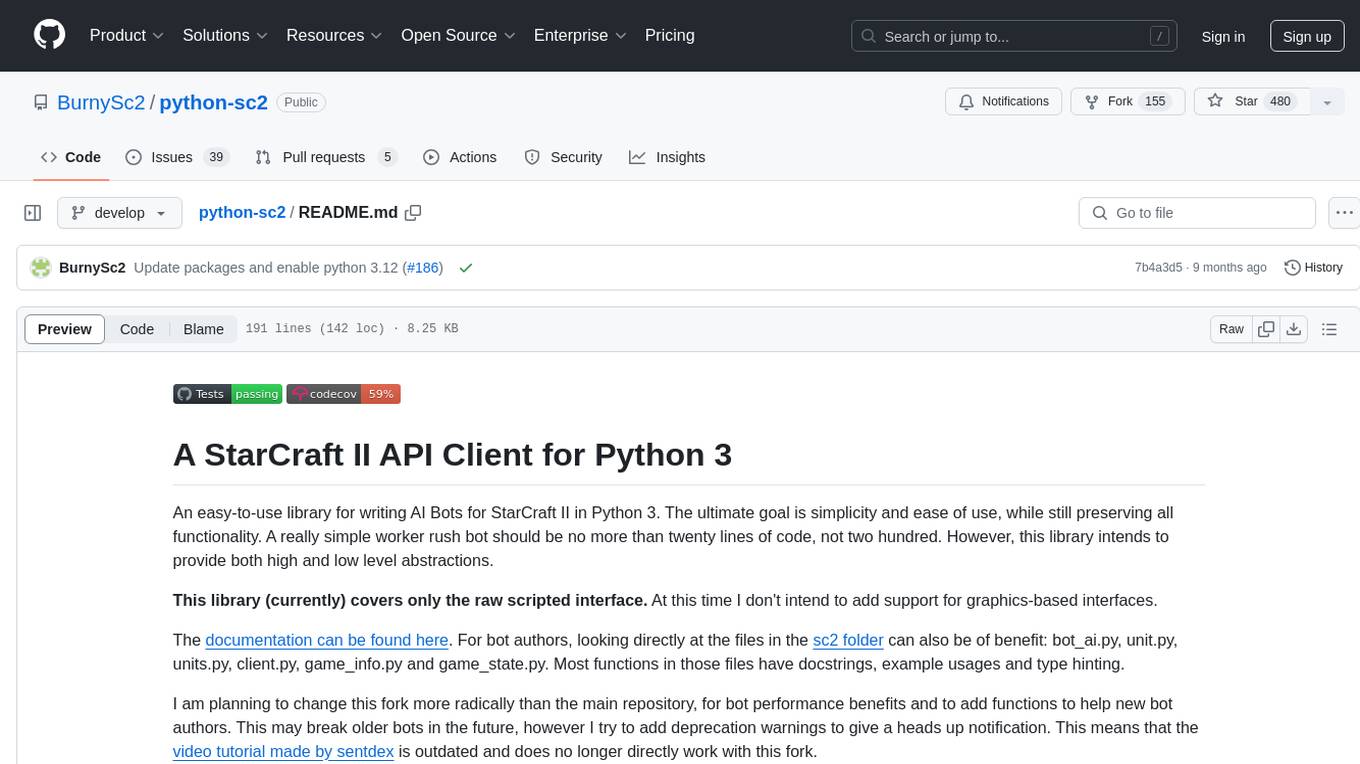
python-sc2
python-sc2 is an easy-to-use library for writing AI Bots for StarCraft II in Python 3. It aims for simplicity and ease of use while providing both high and low level abstractions. The library covers only the raw scripted interface and intends to help new bot authors with added functions. Users can install the library using pip and need a StarCraft II executable to run bots. The API configuration options allow users to customize bot behavior and performance. The community provides support through Discord servers, and users can contribute to the project by creating new issues or pull requests following style guidelines.

aider-composer
Aider Composer is a VSCode extension that integrates Aider into your development workflow. It allows users to easily add and remove files, toggle between read-only and editable modes, review code changes, use different chat modes, and reference files in the chat. The extension supports multiple models, code generation, code snippets, and settings customization. It has limitations such as lack of support for multiple workspaces, Git repository features, linting, testing, voice features, in-chat commands, and configuration options.

firebase-ios-sdk
This repository contains the source code for all Apple platform Firebase SDKs except FirebaseAnalytics. Firebase is an app development platform with tools to help you build, grow, and monetize your app. It provides installation methods like Standard pod install, Swift Package Manager, Installing from the GitHub repo, and Experimental Carthage. Development requires Xcode 16.2 or later, and supports CocoaPods and Swift Package Manager. The repository includes instructions for adding a new Firebase Pod, managing headers and imports, code formatting, running unit tests, running sample apps, and generating coverage reports. Specific component instructions are provided for Firebase AI Logic, Firebase Auth, Firebase Database, Firebase Dynamic Links, Firebase Performance Monitoring, Firebase Storage, and Push Notifications. Firebase also offers beta support for macOS, Catalyst, and tvOS, with community support for visionOS and watchOS.
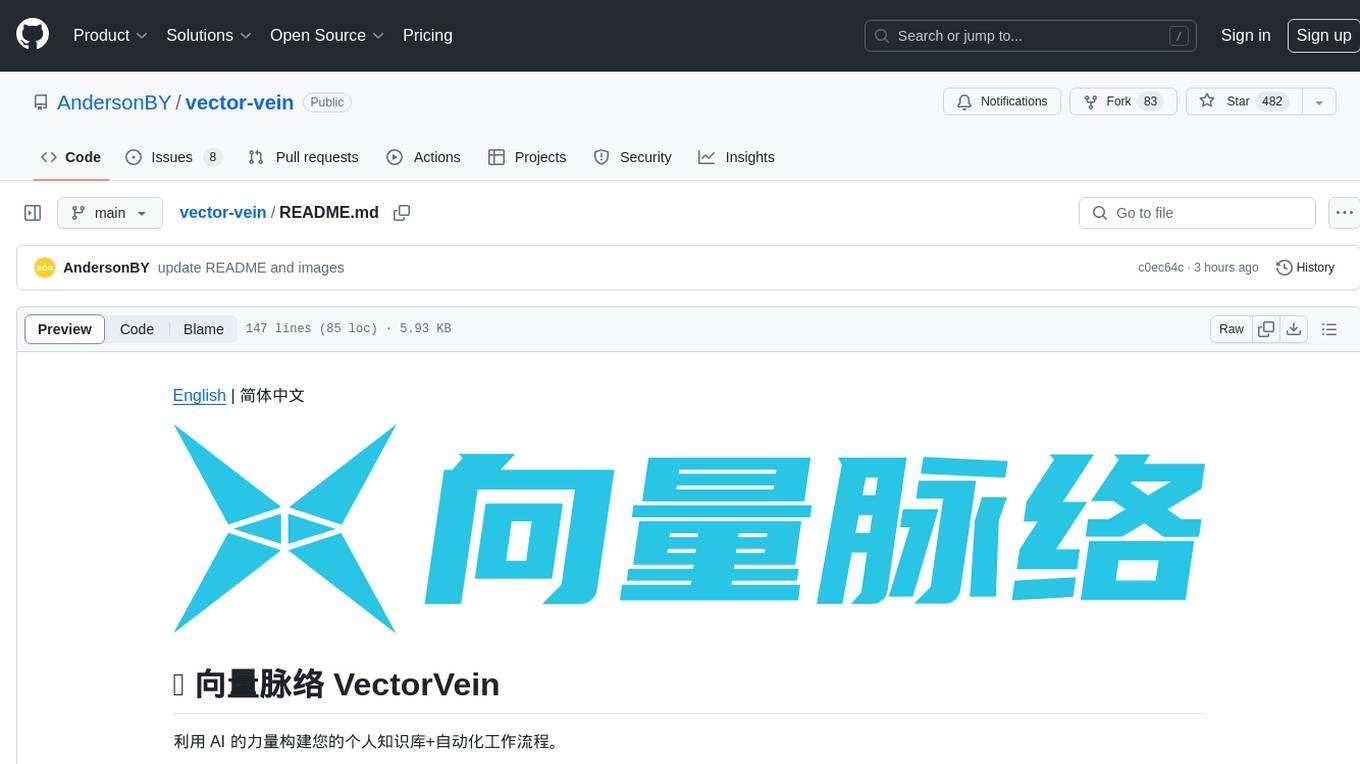
vector-vein
VectorVein is a no-code AI workflow software inspired by LangChain and langflow, aiming to combine the powerful capabilities of large language models and enable users to achieve intelligent and automated daily workflows through simple drag-and-drop actions. Users can create powerful workflows without the need for programming, automating all tasks with ease. The software allows users to define inputs, outputs, and processing methods to create customized workflow processes for various tasks such as translation, mind mapping, summarizing web articles, and automatic categorization of customer reviews.

reai-ghidra
The RevEng.AI Ghidra Plugin by RevEng.ai allows users to interact with their API within Ghidra for Binary Code Similarity analysis to aid in Reverse Engineering stripped binaries. Users can upload binaries, rename functions above a confidence threshold, and view similar functions for a selected function.

mcp-scan
MCP-Scan is a security scanning tool designed to detect common security vulnerabilities in Model Context Protocol (MCP) servers. It can auto-discover various MCP configurations, scan both local and remote servers for security issues like prompt injection attacks, tool poisoning attacks, and toxic flows. The tool operates in two main modes - 'scan' for static scanning of installed servers and 'proxy' for real-time monitoring and guardrailing of MCP connections. It offers features like scanning for specific attacks, enforcing guardrailing policies, auditing MCP traffic, and detecting changes to MCP tools. MCP-Scan does not store or log usage data and can be used to enhance the security of MCP environments.

vectara-answer
Vectara Answer is a sample app for Vectara-powered Summarized Semantic Search (or question-answering) with advanced configuration options. For examples of what you can build with Vectara Answer, check out Ask News, LegalAid, or any of the other demo applications.

0chain
Züs is a high-performance cloud on a fast blockchain offering privacy and configurable uptime. It uses erasure code to distribute data between data and parity servers, allowing flexibility for IT managers to design for security and uptime. Users can easily share encrypted data with business partners through a proxy key sharing protocol. The ecosystem includes apps like Blimp for cloud migration, Vult for personal cloud storage, and Chalk for NFT artists. Other apps include Bolt for secure wallet and staking, Atlus for blockchain explorer, and Chimney for network participation. The QoS protocol challenges providers based on response time, while the privacy protocol enables secure data sharing. Züs supports hybrid and multi-cloud architectures, allowing users to improve regulatory compliance and security requirements.

aioli
Aioli is a library for running genomics command-line tools in the browser using WebAssembly. It creates a single WebWorker to run all WebAssembly tools, shares a filesystem across modules, and efficiently mounts local files. The tool encapsulates each module for loading, does WebAssembly feature detection, and communicates with the WebWorker using the Comlink library. Users can deploy new releases and versions, and benefit from code reuse by porting existing C/C++/Rust/etc tools to WebAssembly for browser use.

minecraft-mcp-server
Minecraft MCP Server is a bot powered by large language models and Mineflayer API. It uses the Model Context Protocol (MCP) to enable models like Claude to control a Minecraft character. The bot allows users to interact with Minecraft through commands and chat messages, facilitating tasks such as movement, inventory management, block interaction, entity interaction, and more. Users can also upload images of buildings and ask the bot to build them. The tool is designed to work with Claude Desktop and requires specific configurations for Minecraft and MCP clients. Contributions to the project, including refactoring, testing, documentation, and new functionality, are welcome.

ShellOracle
ShellOracle is an innovative terminal utility designed for intelligent shell command generation, bringing a new level of efficiency to your command-line interactions. It supports seamless shell command generation from written descriptions, command history for easy reference, Unix pipe support for advanced command chaining, self-hosted for full control over your environment, and highly configurable to adapt to your preferences. It can be easily installed using pipx, upgraded with simple commands, and used as a BASH/ZSH widget activated by the CTRL+F keyboard shortcut. ShellOracle can also be run as a Python module or using its entrypoint 'shor'. The tool supports providers like Ollama, OpenAI, and LocalAI, with detailed instructions for each provider. Configuration options are available to customize the utility according to user preferences and requirements. ShellOracle is compatible with BASH and ZSH on macOS and Linux, with no specific hardware requirements for cloud providers like OpenAI.

LLMFlex
LLMFlex is a python package designed for developing AI applications with local Large Language Models (LLMs). It provides classes to load LLM models, embedding models, and vector databases to create AI-powered solutions with prompt engineering and RAG techniques. The package supports multiple LLMs with different generation configurations, embedding toolkits, vector databases, chat memories, prompt templates, custom tools, and a chatbot frontend interface. Users can easily create LLMs, load embeddings toolkit, use tools, chat with models in a Streamlit web app, and serve an OpenAI API with a GGUF model. LLMFlex aims to offer a simple interface for developers to work with LLMs and build private AI solutions using local resources.

vscode-reborn-ai
VSCode Reborn AI is a tool that allows users to write, refactor, and improve code in Visual Studio Code using artificial intelligence. Users can work offline with AI using a local LLM. The tool provides enhanced support for OpenRouter.ai API and ollama. It also offers compatibility with various local LLMs and alternative APIs. Additionally, it includes features such as internationalization, development setup instructions, testing in VS Code, packaging for VS Code, tech stack details, and licensing information.
For similar tasks

paddler
Paddler is an open-source load balancer and reverse proxy designed specifically for optimizing servers running llama.cpp. It overcomes typical load balancing challenges by maintaining a stateful load balancer that is aware of each server's available slots, ensuring efficient request distribution. Paddler also supports dynamic addition or removal of servers, enabling integration with autoscaling tools.

mcp-hub
MCP Hub is a centralized manager for Model Context Protocol (MCP) servers, offering dynamic server management and monitoring, REST API for tool execution and resource access, MCP Server marketplace integration, real-time server status tracking, client connection management, and process lifecycle handling. It acts as a central management server connecting to and managing multiple MCP servers, providing unified API endpoints for client access, handling server lifecycle and health monitoring, and routing requests between clients and MCP servers.
For similar jobs

flux-aio
Flux All-In-One is a lightweight distribution optimized for running the GitOps Toolkit controllers as a single deployable unit on Kubernetes clusters. It is designed for bare clusters, edge clusters, clusters with restricted communication, clusters with egress via proxies, and serverless clusters. The distribution follows semver versioning and provides documentation for specifications, installation, upgrade, OCI sync configuration, Git sync configuration, and multi-tenancy configuration. Users can deploy Flux using Timoni CLI and a Timoni Bundle file, fine-tune installation options, sync from public Git repositories, bootstrap repositories, and uninstall Flux without affecting reconciled workloads.

paddler
Paddler is an open-source load balancer and reverse proxy designed specifically for optimizing servers running llama.cpp. It overcomes typical load balancing challenges by maintaining a stateful load balancer that is aware of each server's available slots, ensuring efficient request distribution. Paddler also supports dynamic addition or removal of servers, enabling integration with autoscaling tools.
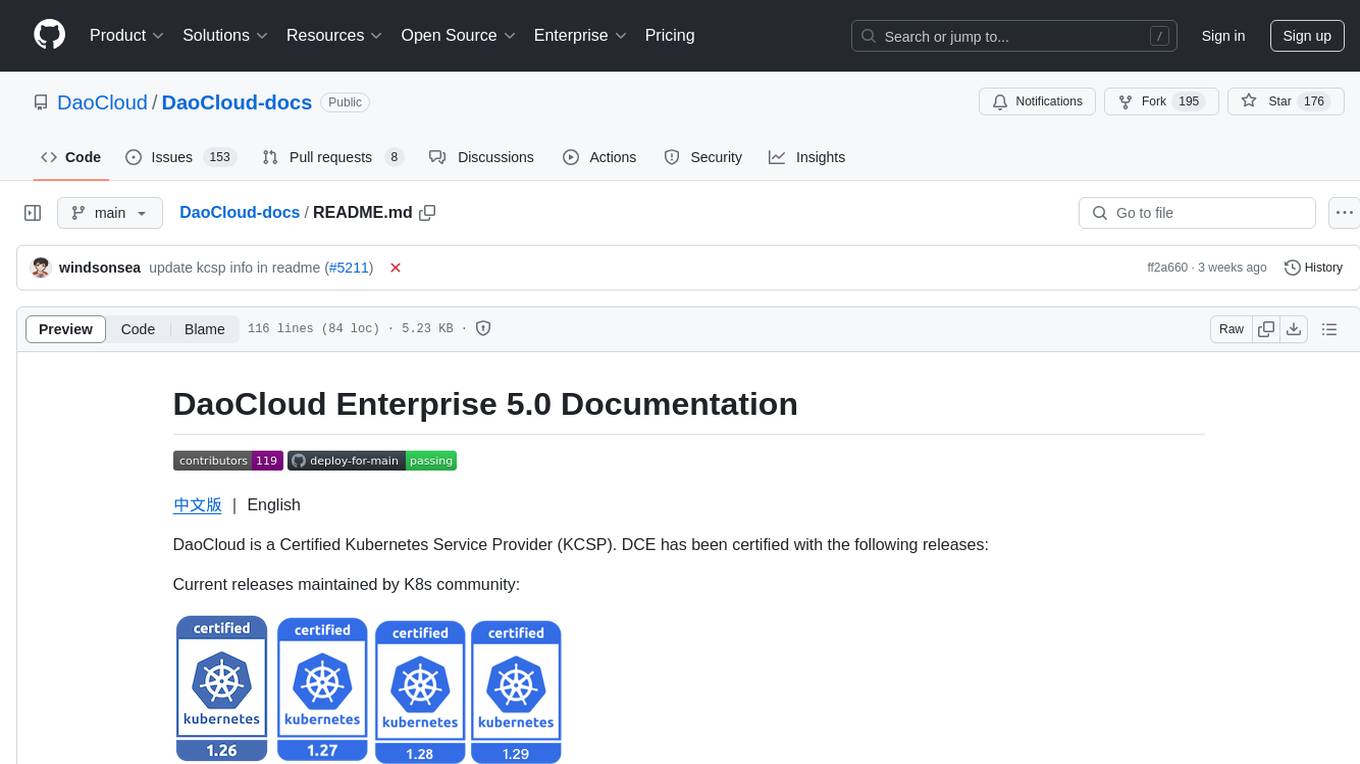
DaoCloud-docs
DaoCloud Enterprise 5.0 Documentation provides detailed information on using DaoCloud, a Certified Kubernetes Service Provider. The documentation covers current and legacy versions, workflow control using GitOps, and instructions for opening a PR and previewing changes locally. It also includes naming conventions, writing tips, references, and acknowledgments to contributors. Users can find guidelines on writing, contributing, and translating pages, along with using tools like MkDocs, Docker, and Poetry for managing the documentation.

ztncui-aio
This repository contains a Docker image with ZeroTier One and ztncui to set up a standalone ZeroTier network controller with a web user interface. It provides features like Golang auto-mkworld for generating a planet file, supports local persistent storage configuration, and includes a public file server. Users can build the Docker image, set up the container with specific environment variables, and manage the ZeroTier network controller through the web interface.

devops-gpt
DevOpsGPT is a revolutionary tool designed to streamline your workflow and empower you to build systems and automate tasks with ease. Tired of spending hours on repetitive DevOps tasks? DevOpsGPT is here to help! Whether you're setting up infrastructure, speeding up deployments, or tackling any other DevOps challenge, our app can make your life easier and more productive. With DevOpsGPT, you can expect faster task completion, simplified workflows, and increased efficiency. Ready to experience the DevOpsGPT difference? Visit our website, sign in or create an account, start exploring the features, and share your feedback to help us improve. DevOpsGPT will become an essential tool in your DevOps toolkit.
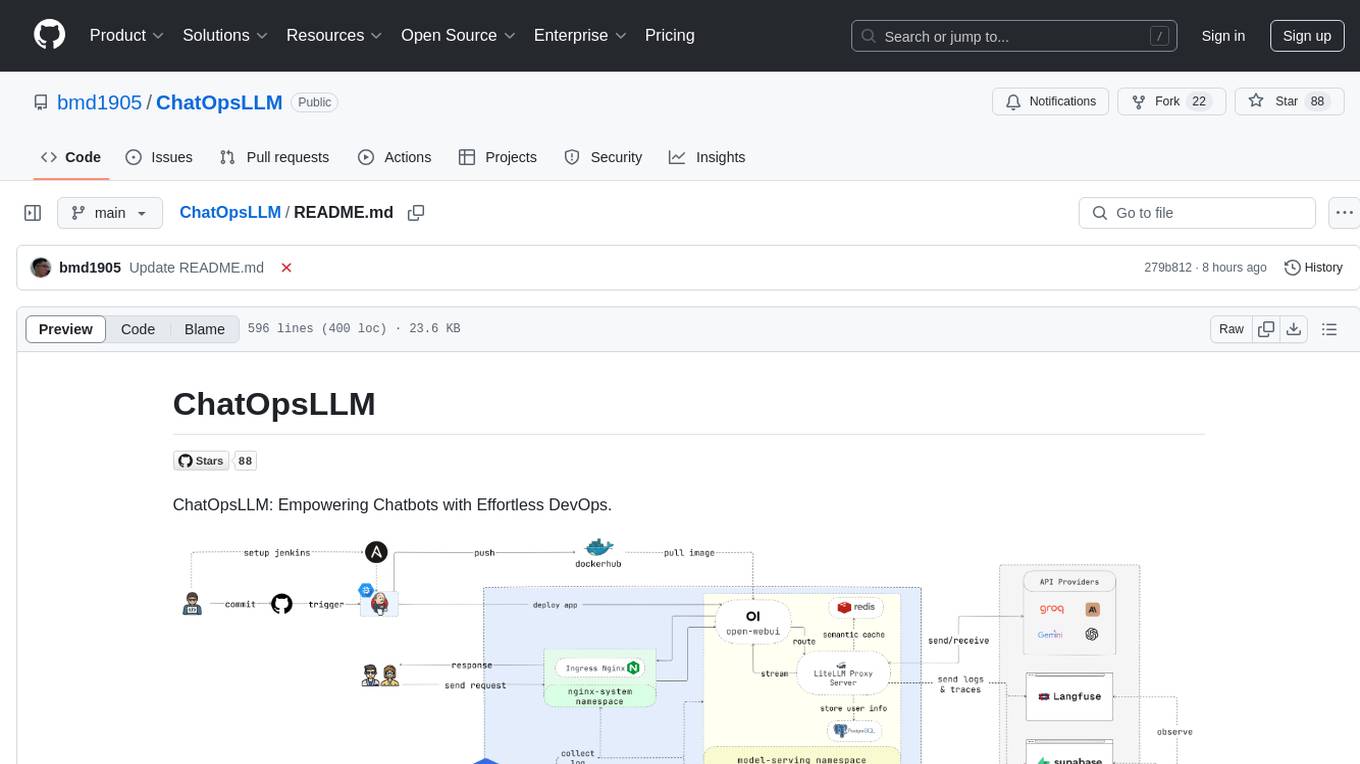
ChatOpsLLM
ChatOpsLLM is a project designed to empower chatbots with effortless DevOps capabilities. It provides an intuitive interface and streamlined workflows for managing and scaling language models. The project incorporates robust MLOps practices, including CI/CD pipelines with Jenkins and Ansible, monitoring with Prometheus and Grafana, and centralized logging with the ELK stack. Developers can find detailed documentation and instructions on the project's website.
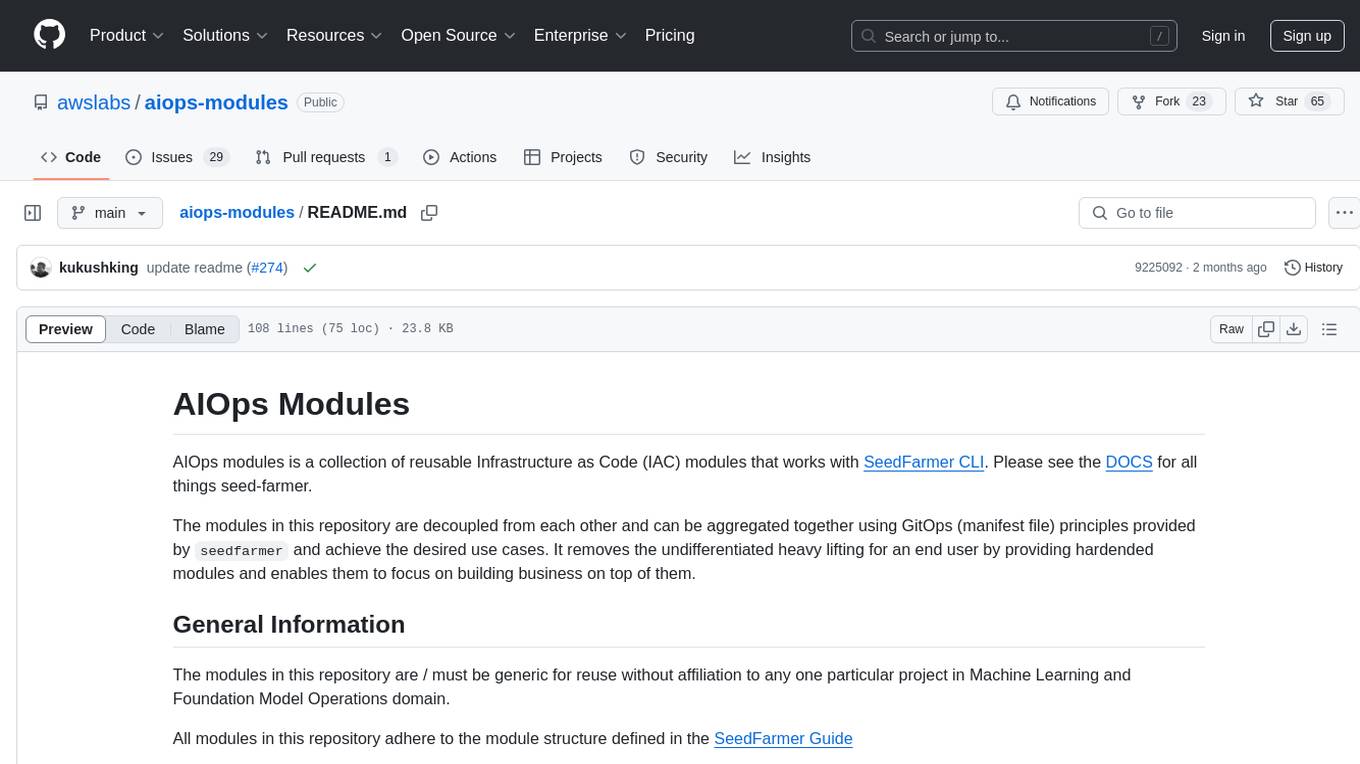
aiops-modules
AIOps Modules is a collection of reusable Infrastructure as Code (IAC) modules that work with SeedFarmer CLI. The modules are decoupled and can be aggregated using GitOps principles to achieve desired use cases, removing heavy lifting for end users. They must be generic for reuse in Machine Learning and Foundation Model Operations domain, adhering to SeedFarmer Guide structure. The repository includes deployment steps, project manifests, and various modules for SageMaker, Mlflow, FMOps/LLMOps, MWAA, Step Functions, EKS, and example use cases. It also supports Industry Data Framework (IDF) and Autonomous Driving Data Framework (ADDF) Modules.

3FS
The Fire-Flyer File System (3FS) is a high-performance distributed file system designed for AI training and inference workloads. It leverages modern SSDs and RDMA networks to provide a shared storage layer that simplifies development of distributed applications. Key features include performance, disaggregated architecture, strong consistency, file interfaces, data preparation, dataloaders, checkpointing, and KVCache for inference. The system is well-documented with design notes, setup guide, USRBIO API reference, and P specifications. Performance metrics include peak throughput, GraySort benchmark results, and KVCache optimization. The source code is available on GitHub for cloning and installation of dependencies. Users can build 3FS and run test clusters following the provided instructions. Issues can be reported on the GitHub repository.